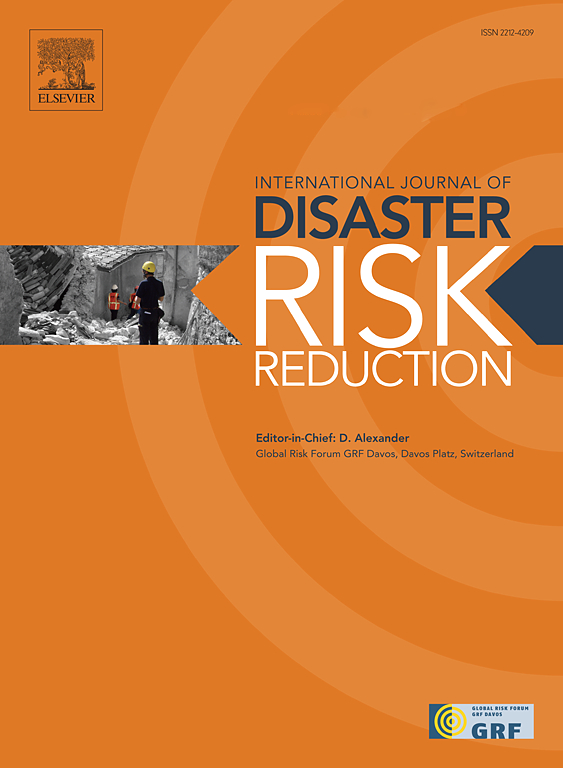滑坡-桥梁相互作用:基于InSAR数据和数值模拟的综合方法
IF 4.5
1区 地球科学
Q1 GEOSCIENCES, MULTIDISCIPLINARY
International journal of disaster risk reduction
Pub Date : 2025-05-29
DOI:10.1016/j.ijdrr.2025.105568
引用次数: 0
摘要
滑坡与基础设施(如桥梁)相互作用,需要进行全面分析,以充分理解和解决这种相互作用的复杂性。本研究提出了一种将InSAR卫星监测与三维数值模拟相结合的综合方法来分析滑坡对桥梁的影响。虽然案例研究是示范性的,但所获得的结果具有普遍性,适用于类似的情况。与单独使用每一种方法相比,InSAR和数值模拟的结合提供了补充和更详细的信息。InSAR分析提供了地表变形的概述,允许对运动进行大规模监测,并且通过数值建模解决了其在提供完整三维信息方面的局限性,从而能够分解滑坡主要方向的运动,精确识别运动轨迹。结果显示主要运动在横向方向,与较不显著的垂直分量,与观察到的运动学一致。InSAR数据允许将数值模拟估计与实际观测进行比较,从而增强了模拟的一致性。这些数据揭示了桥梁上游的重大移动,证实了通过建模确定的关键区域,这弥补了下游卫星数据的缺乏,显示了强烈的位移。该模型还强调了桥梁结构元素的显著位移,以及滑坡的水平推力引起的下游倾斜。综合方法使人们更清楚地了解滑坡动态及其对基础设施的影响,为脆弱地区的监测和风险管理提供了宝贵的工具。本文章由计算机程序翻译,如有差异,请以英文原文为准。
Landslide-Bridge Interaction: A combined approach based on InSAR data and numerical modelling
Landslides that interact with infrastructure, such as bridges, demand a comprehensive analysis to fully understand and address the complexities of this interaction. This study proposes an integrated approach that combines InSAR satellite monitoring with three-dimensional numerical modelling to analyse the effect of a landslide on a bridge. Although the case study is exemplary, the results obtained are of a general nature and applicable to similar contexts. The integration of InSAR and numerical modelling provided complementary and more detailed information compared to the isolated use of each approach. The InSAR analysis offered an overview of surface deformations, allowing for large-scale monitoring of movements, and its limitation in providing complete three-dimensional information was addressed by the numerical modelling, which enabled the decomposition of movements along the main direction of the landslide, precisely identifying the movement trajectory. The results showed predominant movements in the transverse direction, with a less significant vertical component, consistent with the observed kinematics. InSAR data allowed for the comparison of numerical modelling estimates with real observations, enhancing the consistency of the simulations. These data revealed significant movements upstream of the bridge, confirming the critical areas identified by modelling, which compensated for the lack of satellite data downstream, showing intense displacements. The modelling also highlighted significant displacements in the bridge’s structural elements, with downstream tilting caused by the horizontal thrust of the landslide. The integrated approach offered a clearer understanding of landslide dynamics and their impact on infrastructure, offering a valuable tool for monitoring and risk management in vulnerable areas.
求助全文
通过发布文献求助,成功后即可免费获取论文全文。
去求助
来源期刊

International journal of disaster risk reduction
GEOSCIENCES, MULTIDISCIPLINARYMETEOROLOGY-METEOROLOGY & ATMOSPHERIC SCIENCES
CiteScore
8.70
自引率
18.00%
发文量
688
审稿时长
79 days
期刊介绍:
The International Journal of Disaster Risk Reduction (IJDRR) is the journal for researchers, policymakers and practitioners across diverse disciplines: earth sciences and their implications; environmental sciences; engineering; urban studies; geography; and the social sciences. IJDRR publishes fundamental and applied research, critical reviews, policy papers and case studies with a particular focus on multi-disciplinary research that aims to reduce the impact of natural, technological, social and intentional disasters. IJDRR stimulates exchange of ideas and knowledge transfer on disaster research, mitigation, adaptation, prevention and risk reduction at all geographical scales: local, national and international.
Key topics:-
-multifaceted disaster and cascading disasters
-the development of disaster risk reduction strategies and techniques
-discussion and development of effective warning and educational systems for risk management at all levels
-disasters associated with climate change
-vulnerability analysis and vulnerability trends
-emerging risks
-resilience against disasters.
The journal particularly encourages papers that approach risk from a multi-disciplinary perspective.
 求助内容:
求助内容: 应助结果提醒方式:
应助结果提醒方式:


